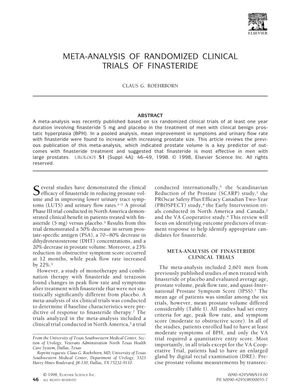TLDR Finasteride effectively treats BPH and hair loss but may cause sexual side effects.
This document is a collection of summaries and findings from various meta-analyses and clinical trials of finasteride, a drug used to treat benign prostatic hyperplasia (BPH) and male pattern hair loss. The studies found that finasteride is effective in reducing symptoms and improving urinary flow rate in patients with BPH, but is associated with an increased risk of sexual side effects. The drug is also effective in treating male pattern hair loss, but may not be suitable for all patients. Prostate volume is a predictor of response to finasteride therapy, with larger prostates showing better response.
 728 citations
,
August 1996 in “The New England Journal of Medicine”
728 citations
,
August 1996 in “The New England Journal of Medicine” Terazosin and finasteride effectively treat BPH, but combining them adds no extra benefit.
 1040 citations
,
October 1992 in “The New England Journal of Medicine”
1040 citations
,
October 1992 in “The New England Journal of Medicine” Finasteride effectively treats BPH but may increase sexual dysfunction risk.
 11 citations
,
April 2013 in “Journal of Agricultural and Food Chemistry”
11 citations
,
April 2013 in “Journal of Agricultural and Food Chemistry” Monascus helps prevent baldness, prostate issues, and may be a natural alternative to medications.
 8 citations
,
July 2018 in “Current Sexual Health Reports”
8 citations
,
July 2018 in “Current Sexual Health Reports” Finasteride can cause lasting sexual dysfunction, depression, and other side effects, needing more research for treatment.
 3 citations
,
April 2021 in “Journal of Medicinal Chemistry”
3 citations
,
April 2021 in “Journal of Medicinal Chemistry” Finasteride may affect PNMT, causing side effects.
408 citations
,
May 2004 in “The Journal of clinical endocrinology and metabolism/Journal of clinical endocrinology & metabolism” Dutasteride more effectively lowers DHT levels in men with enlarged prostates than finasteride.
 June 2023 in “International journal of pharmaceutical quality assurance”
June 2023 in “International journal of pharmaceutical quality assurance” Eclipta alba extract could be a promising natural treatment for hair loss.
 13 citations
,
June 2018 in “Current Urology Reports”
13 citations
,
June 2018 in “Current Urology Reports” Hair loss drugs may cause sexual issues and infertility in men.







